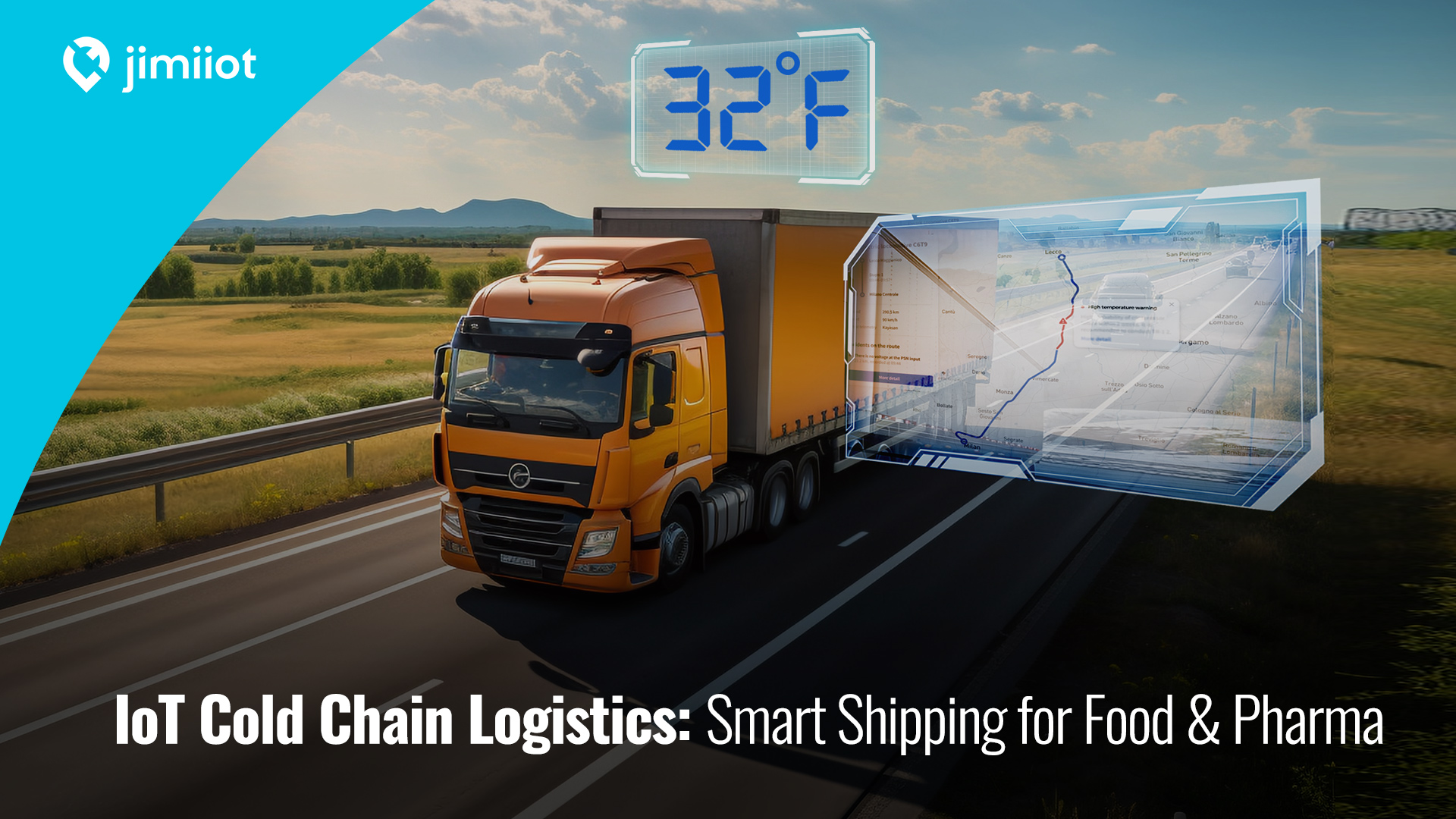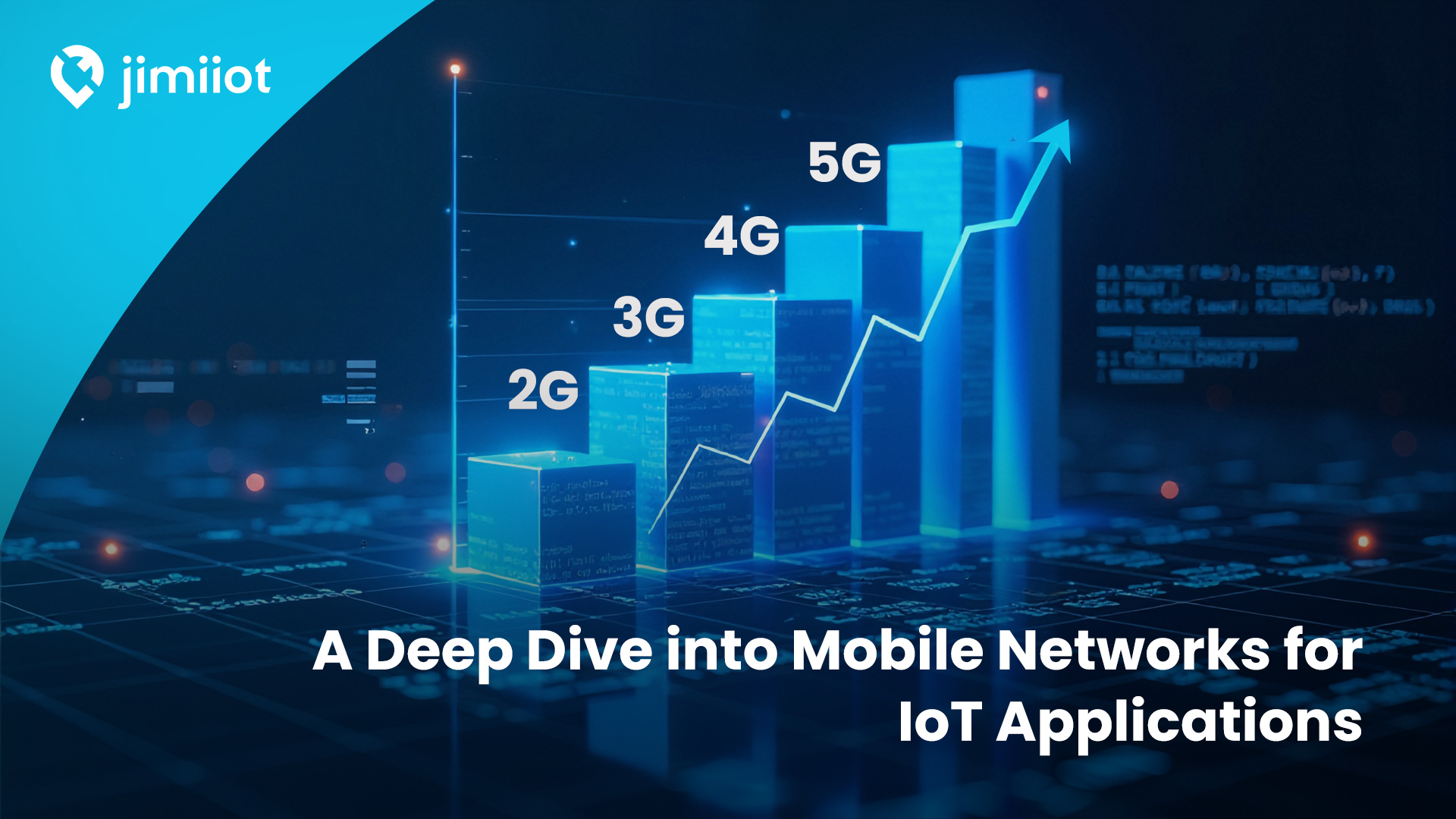IoT cold chain logistics is transforming the transportation of perishable goods like pharmaceuticals and fresh produce in North America. A cold chain is a temperature-controlled supply system that ensures these sensitive items remain safe throughout their journey. In 2024, the food cold-chain logistics market alone reached $114.17 billion and is projected to hit $204.53 billion by 2030 – highlighting the importance of smart, IoT-powered monitoring and visibility.

IoT-Enabled Visibility and Real-Time Monitoring
Modern IoT (Internet of Things) devices are transforming cold-chain logistics by providing constant visibility into every shipment. Wireless trackers equipped with GPS/BDS positioning and environmental sensors continuously feed data on location, temperature and humidity to cloud platforms. This real-time monitoring allows logistics managers to detect deviations immediately and respond before product quality is compromised. For example, an unexpected rise in cargo temperature can trigger alerts so that trucks are rerouted to cool down or offload goods into an alternative refrigerated trailer. Such data-driven visibility not only prevents waste and non-compliance, but also drives efficiency – companies can optimize routes, balance loads and ensure timely deliveries based on live tracking information. In short, IoT “revolutionizes” temperature monitoring in the cold chain by delivering unprecedented control and traceability.
- End-to-end Condition Sensing: Continuous sensing of temperature, humidity and motion inside pallets or containers ensures that any excursion outside defined thresholds is logged.
- Precise Location Tracking: GPS (and multi-modal positioning) provides real-time visibility of trucks, trailers or packages, enabling efficient route planning and proof-of-delivery.
- Instant Alerts and Alarms: Systems generate immediate notifications (via SMS, email or platform) if temperature/humidity readings go awry, or if a device is removed or tampered with.
- Integrated Data Analytics: Collected data can feed predictive models (AI/ML), supporting forecasts of delay or equipment failures, and improving future planning.
Thanks to these IoT capabilities, shippers gain a “consolidated view” of their cold chain. Devices with adaptive tracking balance update frequency and battery life, switching to frequent reporting during transit and power-saving modes when stationary. Bluetooth sensors and tags can further extend visibility inside warehouses and distribution centers. In this way, a modern IoT solution converts a traditional refrigerated truck into a smart vehicle that self-documents its cargo’s conditions.
Protecting Fresh Produce in Transit
Fresh fruits, vegetables, meat and seafood make up a large share of North American cold-chain demand. In fact, roughly 60% of fresh produce consumed in North America passes through some form of cold-chain distribution. These perishables must not only be kept cold, but often within tight humidity ranges to prevent wilting or mold. IoT trackers on refrigerated trucks and containers ensure that climate-controlled air (e.g. 0–4 °C for lettuce or 2–8 °C for berries) is maintained throughout the journey. If, say, a truck’s refrigeration unit begins to fail, the sensor immediately notifies operators to switch load or adjust settings. This real-time data loop greatly reduces spoilage and product shrink. In practice, a B2B grocery distributor or produce wholesaler using IoT devices will see far fewer bins rejected due to thermal abuse.
IoT solutions also support operational efficiencies in produce logistics. By logging environmental and location data, companies can analyze which routes, trucks or packing practices best preserve freshness. For instance, analytics might show that avoiding certain highways at midday cuts cooling demands, or that pre-cooling pallets at the farm leads to less temperature fluctuation. These insights lead to smarter scheduling of refrigerated vehicles and more accurate inventory forecasting. Collectively, the industry trend is clear: IoT adoption for real-time monitoring is a major driver of efficiency and reduced spoilage in the North American food cold chain.
Safeguarding Pharmaceutical Shipments
Temperature-sensitive pharmaceuticals and biologics (like vaccines and injectables) impose even stricter requirements. Many vaccines must be kept within ±2 °C of their setpoint, and some require ultra-cold storage (below –70 °C at earlier steps). Any lapse can render a batch ineffective. Thus regulatory bodies – FDA, WHO, IATA and others – are increasingly mandating continuous monitoring during transit. In practice, an IoT tracker attached to a pallet of vaccines will record and transmit temperature and location every few minutes. Health and pharma logistics benefit from this rigor: for example, a connected container carrying COVID-19 vaccines can alert a manager in real time if temperatures edge toward danger, rather than discovering the problem days later. IoT systems can also log humidity and shock/tamper events, adding extra layers of quality assurance.
A vaccine cold-chain box with temperature-monitoring sensor (training exercise). In North America’s vaccine distribution, such trackers are already used to meet standards like FDA’s Good Distribution Practices and WHO’s cold-chain guidelines. The data provide an auditable record that shipments complied with required ranges. Moreover, cloud platforms can aggregate data across many pharma shipments, alerting on broader risks (e.g. a regional heating problem in a warehouse). The payoff is enormous: preventing just one large spoilage incident (e.g. dozens of lost vaccine doses) yields cost savings that justify the investment in IoT monitoring equipment. In summary, smart trackers give pharmaceutical shippers the assurance they need that patient safety is never compromised by a break in the cold chain.
Connectivity and Data Management
These IoT solutions rely on robust connectivity and data infrastructure. In North America’s vast logistics networks, asset trackers typically use cellular (4G LTE, LTE-M or NB-IoT) along with GPS. One technical challenge is ensuring always-on connectivity across borders and rural areas. New SIM technologies (embedded SIM or multi-IMSI cards) allow devices to switch among carriers automatically, preventing data gaps. For example, as a truck crosses from the U.S. into Canada, an intelligent SIM can latch onto the local network without manual roaming setup. Devices also include local storage to handle dead zones: the LL309 tracker, for instance, caches up to 20,000 readings on board, which can be exported later via USB.
Once data reach the cloud, sophisticated platforms and dashboards allow B2B customers to visualize their cold chain in real time. Alerts can be sent via mobile apps or messaging to operations teams. Over time, historical data enable machine-learning algorithms to predict issues (like an aging refrigeration unit likely to fail). This “smart analytics” approach means the system improves continually. Integrations with ERP and supply-chain management software also streamline compliance reporting. In effect, the combination of IoT connectivity and big data forms the backbone of next-generation cold chain operations.
Emerging Trends: AI, Blockchain and Sustainability
Looking ahead, several technological trends will further enhance North American cold chains. Some key directions include:
- Predictive Analytics & AI: Machine learning will predict temperature excursions before they happen. For example, patterns in sensor data could trigger alerts to pre-cool cargo when a delay is likely. As data volumes grow, AI can optimize energy use in trailers and automatically adjust setpoints.
- Blockchain Traceability: Distributed ledger technology is emerging to record cold-chain data immutably. By hashing temperature logs on blockchain, companies gain tamper-proof audit trails for every shipment. This ensures regulatory compliance and builds trust with customers.
- Next-Gen Connectivity (5G/NB-IoT): New wireless standards will allow even lower-power, more ubiquitous connectivity. 5G-enabled trackers could support ultra-reliable low-latency links, useful for autonomous vehicles or drones in delivery.
- Eco-Friendly Refrigeration: There’s growing demand for sustainable cold chain practices. This includes using low-emission refrigerants, solar-powered trailers, and optimizing routes to cut fuel use. Companies are also reducing waste by minimizing spoiled goods. “Sustainable initiatives are driving investment in energy-efficient cold-chain solutions,” industry analysts note.
- Regulatory Emphasis: Organizations like FDA, WHO and IATA now push real-time monitoring. For instance, the FDA’s guidelines for biologics explicitly endorse electronic data logging. Increased enforcement of such standards will make IoT monitoring a best practice rather than a luxury.
Taken together, these trends suggest that cold-chain technology will become more predictive, transparent and green. B2B providers who adopt these innovations will enjoy competitive advantage through higher service quality and lower waste.
Example: Jimi IoT’s LL309 Temperature & Humidity Tracker
One practical solution for cold-chain monitoring is Jimi IoT’s LL309 tracker. This 4G/LTE asset tracker is designed specifically for refrigerated logistics. Its key features include:
- Multi-Source Positioning: GPS (and alternative systems) for precise real-time location tracking on any logistics platform.
- Environmental Sensing: Built-in temperature and humidity sensors continuously measure cargo conditions and automatically trigger alerts if readings stray beyond preset limits.
- Real-Time Data Uplink: Uses LTE connectivity to send live location and environmental data to cloud servers or monitoring apps.
- Local Data Storage: Onboard memory stores up to 20,000 data entries (temperature, humidity, location and alarms) plus an extra 5,000 cached points if cellular coverage is lost. All stored data can be exported via the included Type-C cable.
- Instant Alerts: Configurable alarms notify users of critical events (abnormal temperature/humidity, device removal, etc.) on a platform or designated phone number. This ensures immediate response to any threat.
- Bluetooth Configuration: Device settings can be adjusted on-site using a smartphone app (Jimi IoT Lab for iOS), simplifying setup and maintenance in the field.
- Rugged Design: IP67-rated housing resists dust and water, making the LL309 suitable for harsh transport environments (e.g. refrigerated trucks or open-air shipments).
By combining these capabilities, the LL309 offers B2B cold-chain customers an all-in-one tracking package. For example, a refrigerated trucking company can attach LL309 units to its trailers so that each delivery is continuously monitored. If a sensor reports a temperature spike during transit, operations staff can dispatch a technician or redirect the load immediately. Over multiple shipments, the stored data can also be analyzed to optimize fleet performance and maintenance schedules.
Conclusion
North America’s cold-chain logistics is evolving rapidly. With rising demand for fresh and medical products, companies are turning to IoT to ensure shipments stay within safe temperature zones from origin to destination. Cloud-connected trackers and sensors give B2B shippers unprecedented visibility and control – “providing unprecedented control, traceability, and compliance,” as industry experts put it. In the coming years, advances like AI-driven analytics and blockchain will further secure the cold chain, while sustainable practices will reduce environmental impact. In this forward-looking environment, adopting comprehensive IoT solutions – such as the LL309 temperature-humidity tracker – is no longer optional but a strategic necessity. Ultimately, these technologies ensure that North American businesses can deliver perishable goods safely, efficiently and in compliance with regulatory standards.
For businesses shipping temperature-sensitive components across the continent, investing in advanced trackers like the LL309 is no longer optional. It is a way to ensure that every critical part arrives intact, operations run smoothly, and compliance is assured. By integrating such technology into their supply chain, companies can transform the burden of cold chain logistics into a streamlined, data‑driven process – ultimately gaining a competitive edge in the industry.
Why JimiIoT
JimiIoT is a global leader in innovative IoT solutions. We provide cutting-edge hardware and software tailored to enhance efficiency and connectivity. Our range of products includes advanced GPS tracking devices, asset management solutions, smart vehicle dashcams, and telematics platforms. With a focus on technological excellence and customer satisfaction, we empower businesses to optimize operations and gain valuable insights from data-driven analytics. Trust JimiIoT to drive positive change and unlock growth opportunities in the digital age.
If you would like more details, please visit Facebook, LinkedIn, INS, and Twitter pages for further information.

 US
US ES
ES PT
PT TH
TH VN
VN JP
JP



